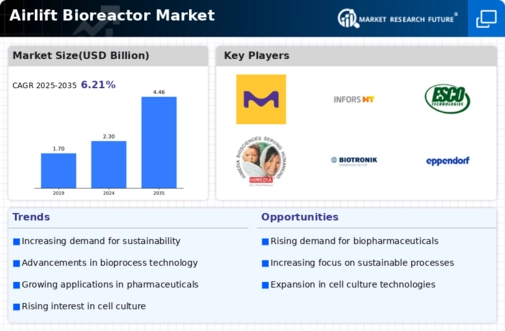Market Growth Projections
The Global Airlift Bioreactor Market Industry is poised for substantial growth, with projections indicating a market value of 2.3 USD Billion in 2024 and an anticipated increase to 4.46 USD Billion by 2035. This growth trajectory reflects a compound annual growth rate (CAGR) of 6.21% from 2025 to 2035. Such projections highlight the increasing reliance on airlift bioreactors in various applications, particularly in biopharmaceutical production. The market's expansion is likely to be driven by technological advancements, rising demand for biopharmaceuticals, and a growing emphasis on sustainability. These factors collectively contribute to a robust outlook for the airlift bioreactor market.
Rising Demand for Biopharmaceuticals
The Global Airlift Bioreactor Market Industry experiences a notable surge in demand for biopharmaceuticals, driven by advancements in biotechnology and an increasing focus on personalized medicine. As the biopharmaceutical sector expands, the need for efficient production systems becomes paramount. Airlift bioreactors offer advantages such as enhanced mass transfer and reduced shear stress, making them suitable for sensitive cell cultures. This trend is reflected in the market's projected growth, with an estimated value of 2.3 USD Billion in 2024, potentially reaching 4.46 USD Billion by 2035. The compound annual growth rate (CAGR) of 6.21% from 2025 to 2035 underscores the importance of these systems in meeting biopharmaceutical production needs.
Global Expansion of Biomanufacturing Facilities
The Global Airlift Bioreactor Market Industry is positively impacted by the global expansion of biomanufacturing facilities. As companies establish new production sites to meet increasing demand for biopharmaceuticals, the need for efficient bioreactor systems becomes critical. Airlift bioreactors, known for their scalability and adaptability, are well-suited for diverse production environments. This expansion is driven by factors such as rising healthcare needs and the pursuit of localized production capabilities. The establishment of new facilities not only supports market growth but also enhances supply chain resilience, ensuring that biopharmaceuticals can be produced closer to end-users.
Sustainability and Environmental Considerations
Sustainability concerns play a crucial role in shaping the Global Airlift Bioreactor Market Industry. As industries strive to minimize their environmental footprint, airlift bioreactors emerge as a viable solution due to their energy efficiency and lower resource consumption. These systems utilize less energy compared to traditional stirred-tank reactors, aligning with global sustainability goals. Furthermore, the ability to operate at lower temperatures and pressures reduces the risk of thermal degradation of sensitive products. This shift towards sustainable practices is likely to drive the adoption of airlift bioreactors, as companies seek to enhance their environmental credentials while maintaining production efficiency.
Technological Advancements in Bioreactor Design
Technological innovations in bioreactor design significantly influence the Global Airlift Bioreactor Market Industry. Enhanced designs, such as improved aeration systems and automation capabilities, contribute to increased efficiency and productivity. These advancements allow for better control of environmental parameters, leading to optimized growth conditions for microorganisms and cells. As a result, manufacturers are increasingly adopting airlift bioreactors to streamline production processes. The integration of smart technologies, including real-time monitoring and data analytics, further enhances operational efficiency. This trend is expected to propel the market forward, aligning with the overall growth trajectory of the biopharmaceutical sector.
Increased Investment in Research and Development
The Global Airlift Bioreactor Market Industry benefits from heightened investment in research and development across various sectors, particularly in pharmaceuticals and biotechnology. This investment fosters innovation and the development of novel bioprocessing techniques, which are essential for the efficient production of complex biologics. As organizations prioritize R&D, the demand for advanced bioreactor systems, including airlift designs, is expected to rise. This trend is indicative of a broader commitment to enhancing production capabilities and improving product quality. The ongoing focus on R&D is likely to sustain market growth, as companies seek to leverage cutting-edge technologies to meet evolving industry demands.




















Leave a Comment